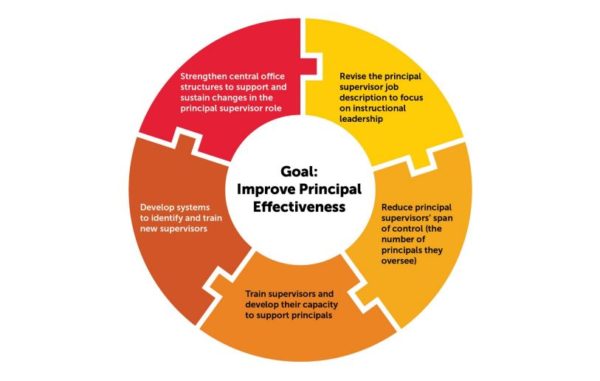 Principals and districts benefit when principal supervisors move beyond the role of administrator to coach and mentor, according to a new Vanderbilt University report.
Principals and districts benefit when principal supervisors move beyond the role of administrator to coach and mentor, according to a new Vanderbilt University report.
It is the first of three studies of The Wallace Foundation’s Principal Supervisor Initiative, a four-year, $24 million effort studied by Vanderbilt and contracted by Mathematica Policy Research.
The report, “A New Role Emerges for Principal Supervisors: Evidence from Six Districts in the Principal Supervisor Initiative,” details the implementation of five key components to reshape the supervisor position in six large, urban school districts. Each district changed the job descriptions and restructured central offices so that principal supervisors could step away from operational, administrative and compliance tasks to coach, mentor and advise principals to be more effective as instructional leaders.

“Executive coaching is prevalent in high-performing organizations, but it’s not typically done in school districts,” said lead investigator Ellen Goldring, Patricia and Rodes Hart Professor of Educational Leadership and Policy. “After three years, we saw substantial change in all districts. They came up with efficient and effective ways to position supervisors so they could fill the coaching and supporting gap.”
Jody Spiro, director of education leadership at The Wallace Foundation, adds: “This new study shows us that school districts participating in the initiative could transform the principal supervisor role into a source of support for principals in leading, teaching and learning. Principals felt better supported and district culture and central office changed for the better. Importantly, the study also makes clear what is needed to make this change happen.”
The six districts are: Broward County Public Schools in Florida; Baltimore City Public Schools in Maryland; Cleveland Metropolitan School District in Ohio; Des Moines Public Schools in Iowa; Long Beach Unified School District in California; and Minneapolis Public Schools in Minnesota.
Five components for restructuring principal supervisor role
1. Revise supervisor’s job description to focus on instructional leadership
Districts worked with stakeholders to revise the supervisor job description to outline the new expectations for the supervisor role, which moved toward a focus on supporting and developing principals in schools and away from overseeing compliance.
“These components laid the groundwork for changes in principal supervisors’ day-to-day work with principals,” Goldring said. “Most principal supervisors reported they now spend the largest share of their time, 63 percent, working directly with principals, engaging in newly developed routines and practices, such as participating in classroom walk-throughs, coaching principals, leading collaborative learning and providing ongoing feedback.”
2. Reduce the number of principals supervisors oversee
The supervisors in the study were initially responsible for an average of 17 principals, though some oversaw as many as 21, making it nearly impossible to meaningfully engage with them all. That number was reduced to an average of 12, with districts hiring additional supervisors. The number of supervisors who reported that they oversaw too many principals declined in every district. Supervisors created networks of principals to facilitate collaboration and learning communities.
3. Provide dedicated professional development
Districts implemented dedicated training programs specifically designed to build supervisors’ capacity in coaching and principal support and development in instruction. For many of them, it was the first time they were provided professional instruction that was crafted to their role. In spring 2017, 80 percent reported participating in such opportunities.
4. Redefine the central office’s role and functions
The districts made substantial progress in restructuring central offices to better align with the revised role of supervisors. They streamlined departments, dismantled barriers that stifled communication and improved processes, resulting in better integration and collaboration across departments.
5. Develop and cultivate new supervisors
Three districts developed and implemented apprenticeship programs, serving as a key strategy for preparing school leaders for principal supervisor positions. These programs featured rigorous selection procedures and offered a mix of training sessions, individual coaching and performance feedback, mentoring from a current principal supervisor, and shadowing of central office leaders.
Facing future challenges
Other school districts can learn from this study both by seeing what is feasible – that the role can be changed – and what is challenging, Goldring believes.
“Reducing the span of control requires districts to shift spending, which was not an option for some. In addition, districts changing the supervisor’s job description necessitated that they also change other central office roles, especially to figure out how to deal with some of the administrative tasks removed from supervisors’ responsibility,” she said. “The process required the balancing of expectations, deepening and developing effective practices for supervisors, and differentiating supports for principals.”
“It’s a heavy lift,” Goldring adds, “but this study represents an incredibly positive example of the power of the supervisor role and a hopeful story about the power of district reform.”
The next report, to be published in July 2019, will measure the Principal Supervisor Initiative’s impact on principal effectiveness. The third report, to be released in December 2019, will compare principal supervision in the six districts in this study with peers in other urban districts.
The study was conducted by Vanderbilt’s Ellen B. Goldring, Jason A. Grissom, Mollie Rubin, Laura K. Rogers and Michael Neel; and Mathematica Policy Research’s Melissa A. Clark.
Download the Report, “A New Role Emerges for Principal Supervisors: Evidence from Six Districts in the Principal Supervisor Initiative,” (New York: The Wallace Foundation, 2018)
More about the collaborators
 The Wallace Foundation seeks to improve education and enrichment for disadvantaged children and foster the vitality of arts for everyone. The foundation has an unusual approach: funding efforts to test innovative ideas for solving important public problems, conducting research to find out what works and what doesn’t and to fill key knowledge gaps – and then communicating the results to help others. Wallace, which works nationally, has five major initiatives under way:
The Wallace Foundation seeks to improve education and enrichment for disadvantaged children and foster the vitality of arts for everyone. The foundation has an unusual approach: funding efforts to test innovative ideas for solving important public problems, conducting research to find out what works and what doesn’t and to fill key knowledge gaps – and then communicating the results to help others. Wallace, which works nationally, has five major initiatives under way:
- School leadership: Strengthening education leadership to improve student achievement.
- Afterschool: Helping selected cities make good afterschool programs available to many more children.
- Building audiences for the arts: Enabling arts organizations to bring the arts to a broader and more diverse group of people.
- Arts education: Expanding arts learning opportunities for children and teens.
- Summer and expanded learning: Better understanding the impact of high-quality summer learning programs on disadvantaged children, and enriching and expanding the school day in ways that benefit students.
 Founded in 1968, Mathematica is committed to improving public well-being through high quality, objective research and collaboration with decision makers across the public and private sectors. Its education experts are established leaders in education program evaluation who work directly with schools and school districts to identify what’s working and opportunities to improve student outcomes.
Founded in 1968, Mathematica is committed to improving public well-being through high quality, objective research and collaboration with decision makers across the public and private sectors. Its education experts are established leaders in education program evaluation who work directly with schools and school districts to identify what’s working and opportunities to improve student outcomes.
Listen to the podcast “Our American States” featuring a discussion about principal supervisors with Peabody professor Mollie Rubin.
A version of this article previously appeared on Research News @ Vanderbilt.